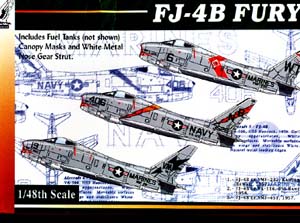Grand Phoenix 1/48 FJ-4B |  | History The first time I saw an FJ-4 it was on my tail. The second time was when I came off cruise and there was a line-up of factory-fresh FJ-4B's waiting for the new guys. How lucky they were! The last time I saw one of either model was at the Pima County Air Museum. In all cases, the Fury remains in my mind as the most attractive of the entire F-86/FJ-2/3/4 series. The FJ-4 and -4B were so different than the FJ-3 that they should have had a separate designation. First flown in late 1954, the production version of the FJ-4 flew in 1955. The FJ-4 (there was no XF-J4) carried 50% more fuel than the -3, it had four underwing pylons and two side-fuselage-mounted speed brakes. In 1958, Marines flew a trans-Pacific flight using drop tanks and air refueling, demonstrating the long range of the Fury. To have a ground attack version, the FJ-4B was rolled out in 1956 and it featured six underwing pylons and it was given an additional set of speed brakes mounted under the horizontal stablizer under the fuselage. Like the FJ-4, the -4B had a shorter rudder than the FJ-3. In some respects, the -4B was a near-sibling to the F-86H. The FJ-4B entered service in 1957. Both models represent some of the last subsonic types in Navy service and they were being replaced in the late 1950's, with final flights made in 1962. In fact, the FJ-4 may have been the Navy's final subsonic fighter. The kit. Grand Phoenix models of the Czech Republic are having Eagle Strike Productions of the USA distribute the 1:48th scale kit of the FJ-4B Fury which sells for almost $50.00. The halves of the fuselage, wing, tail and drop tanks not only do not have locating pegs, but in the case of the wing, the interior surfaces are flat, making gluing a permanent fix on the first try. There is some flashing on parts, and the fuselage right-side half - in my kit - has a gob of plastic obstructing the recess for the wing join. One of each of the wing halves has a rectangular peg which fits into the rectangular opening in the fuselage halves. I found the fit of the peg to the opening very insecure, and it may be necessary to gouge out a channel for a brass rod to provide a spar giving dihedral (or the lack of), and strength. Nose ballast is suggested in the instructions. On the plus side, the kit offers excellent resin parts by Aires, excellent Eagle strike decals, canopy masks and a white metal nose strut. There is a very nice photo-etch interior detail set with an instrument film for the cockpit panel sandwich. The beautiful decals are for Marine squadrons VMF-232 and -451 but the Marines most likely flew FJ-4's, not the -4B. There is a set of decals for Navy squadron VA-116. Many FJ-4's flew clean, without underwing pylons while the kit fuselage definitely is that of the -4B, and those who wish to model the FJ-4 will have a difficult time of it. Check your sources for what Marine squadrons flew, before putting an FJ-4B into Marine markings. According to the Squadron Signal No. 103 "FJ Fury In Action", VMF-232 flew FJ-4's but the decals are enticing to this modeler. On the minus side, no ordnance is included and not all six pylons are provided even though on the underside of the wing there are marks as to where to put the pylons. Conclusions. The FJ-4B was a very elegant-looking, very attractive aircraft and many modelers will no doubt agree with that opinion and want to model the Fury. Even though sources differ as to length of the real FJ-4B, the difference is so minute in 1:48th scale that it is unimportant. My question is: why don't the Czechs use locating pegs? | 









|
